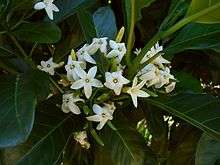Atractocarpus fitzalanii
Atractocarpus fitzalanii, the brown gardenia or yellow mangosteen, is a species of flowering plant in the family Rubiaceae found in tropical Queensland in Australia. The beautifully scented flowers and lush growth has seen this plant enter cultivation in subtropical gardens in Eastern Australia.[2]
| Brown gardenia | |
|---|---|
 | |
| Scientific classification | |
| Kingdom: | Plantae |
| Clade: | Tracheophytes |
| Clade: | Angiosperms |
| Clade: | Eudicots |
| Clade: | Asterids |
| Order: | Gentianales |
| Family: | Rubiaceae |
| Genus: | Atractocarpus |
| Species: | A. fitzalanii |
| Binomial name | |
| Atractocarpus fitzalanii (F.Muell.) Puttock | |
| Synonyms[1] | |
Description
.jpg)
Atractocarpus fitzalanii grows as a woody shrub or small tree some 3–10 m (9.8–32.8 ft) in height. The trunk is covered by smooth grey bark. The large glossy dark green leaves are obovate to oval-shaped and range from 10–18 cm (3.9–7.1 in) long by 3–5 cm (1.2–2.0 in) wide. The yellowish veins and midrib are prominent on the leaf. The new growth is a bright lime green in colour. The small (2-2.5 cm or 1 inch) white fragrant flowers appear from September to November, occur singly and have five lanceolate petals around a tube. The round- or oval-shaped fruit is 3–4 cm in diameter and ripens in April to June.[3] The fragrance of the flowers resembles that of the common gardenia, and fruit can be eaten fresh.[4]
Distribution and habitat
The range is from far north Queensland south through to Mackay. It is found in rainforests and sheltered habitats.[3]
Ecology
Flowers open in the afternoon, and moths then visit the plants. Birds eat the fruit.[5]
Uses
Its bushy lush foliage and bright new growth, fragrant flowers and edible and tasty fruit give it horticultural potential in gardens in subtropical climates.[3] It is suited to a shady position with good drainage in gardens, or moderately to brightly lit indoor spaces.[6]
Taxonomy
Atractocarpus fitzalanii was originally described by German naturalist and Victorian State Botanist Ferdinand von Mueller, who named it in honour of the person who first collected it, Eugene Fitzalan.[7] It is commonly known as the brown gardenia.[3]
Known for many years as Randia fitzalanii,[3][8] it gained its current binomial name in 1999 with the publishing of a genus revision by botanists Christopher Puttock and Christopher Quinn.[9]
Subspecies
Two subspecies have become widely recognised:[1]
- Atractocarpus fitzalanii subsp. fitzalanii
- Atractocarpus fitzalanii subsp. tenuipes Puttock the name derived from the Latin tenuis "slender", and pes "foot".[9]
References
- Kew World Checklist of Selected Plant Families, Atractocarpus fitzalanii
- Society for Growing Australian Plants (Aitkenvale Queensland), Atractocarpus fitzalanii
- Elliot, Rodger W.; Jones, David L.; Blake, Trevor (2002). Encyclopaedia of Australian Plants Suitable for Cultivation: Vol. 8. Port Melbourne: Lothian Press. p. 175. ISBN 0-7344-0378-X.
- "Yellow Mangosteen". Trade Winds Fruit website. Trade Winds Fruit. Retrieved 2009-08-23.
- Puttock CF (1999). "Revision of Atractocarpus (Rubiaceae: Gardenieae) in Australia and New Combinations for Some Extra-Australian Taxa". Australian Systematic Botany. CSIRO Publishing. 12: 271–309. doi:10.1071/SB97030.
- Ratcliffe, David & Patricia (1987). Australian Native Plants for Indoors. Crows Nest, NSW: Little Hills Press. p. 125. ISBN 0-949773-49-2.
- Ferdinand von Mueller. 1860. Essay on the plants collected by Mr. Eugene Fitzalan, during Lieut. Smith's expedition to the estuary of the Burdekin 12. Gardenia fitzalani
- Bentham, George. 1867. Flora Australiensis 3: 411, Randia fitzalani
- Puttock CF, Quinn CJ (1999). "Generic concepts in Australian Gardenieae (Rubiaceae): a cladistic approach". Australian Systematic Botany. CSIRO Publishing. 12 (2): 181–99. doi:10.1071/SB98001.
External links
- "Atractocarpus fitzalanii". Australian Plant Name Index (APNI), IBIS database. Centre for Plant Biodiversity Research, Australian Government.
- World Checklist of Rubiaceae
- Queensland Government, native gardenia, Atractocarpus fitzalanii
- James Cook University (Smithfield Queensland), Discover Nature, Atractocarpus fitzalanii
- Forest Lodge Garden Boutique, Atractocarpus fitzalanii
- Society for Growing Australian Plants (Aitkenvale Queensland), Atractocarpus fitzalanii
| Wikimedia Commons has media related to Atractocarpus fitzalanii. |